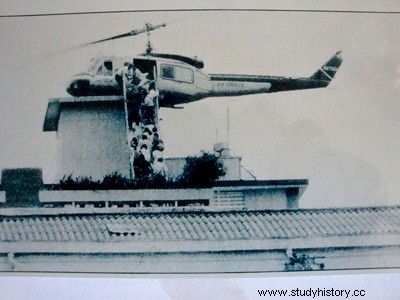
In 1970, the United States thought it was in sight of victory. The meaning of the war had been spelled out in a clear manner, and apparently the people of South Vietnam understood and approved of it.
The economy had been revived. The army had become formidable. A state-of-the-art air force had been set up. Finally, the most important sectors of concentration of Communist supplies, the "sanctuaries" of Laos and Cambodia, had been located, invested and destroyed by the Allied troops.
The final chapter of the American commitment opened with a gigantic communist offensive on March 31, 1972 which was stopped everywhere; the North Vietnamese army was shaken. At that time, peace talks had been under way for years. But what finally concluded these talks was the American response to this failed offensive:the mining of North Vietnamese ports and the massive strategic bombardments launched at the end of 1972 against Hanoi and Haiphong. These raids cost the American bombers dearly (17 B-52s shot down), especially at the beginning; however jamming against SAM-3s and destruction of firing sites increasingly diminished the effectiveness of the North Vietnamese defense.
The losses of B-52s are also proportional to the sorties made between 19 and 31 December (729), in the midst of an anti-aircraft defense of a density never reached (around Hanoi, 26 missile battalions and 360 anti-aircraft gun batteries were concentrated; while Hamburg in 1943 had only 80 batteries). In reality, the losses were less than 2%, a result significantly lower than the losses suffered by the B-17s and B-24s during World War II.
One can reprove these bombardments from a human point of view; militarily they were remarkably effective, and effectively forced the North Vietnamese to accept peace. America then thought it had won the war, and emerged "in honor". But less than two years later the North Vietnamese army was reconstituted and tremendously reinforced by enormous quantities of Soviet equipment.
On the other hand Saigon felt this time abandoned by the United States; Congress was refusing her the help she was asking for. In the spring of 1975 the army of the North invaded the plateaus of South Vietnam; the Thieu regime collapsed; on April 30, Saigon was taken. American or South Vietnamese air superiority had been of little or no use; however, this failure is not to be attributed to Carme, but to the use that was made of it...
